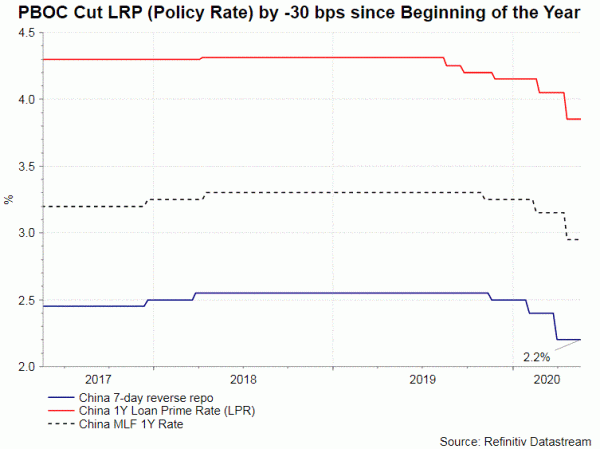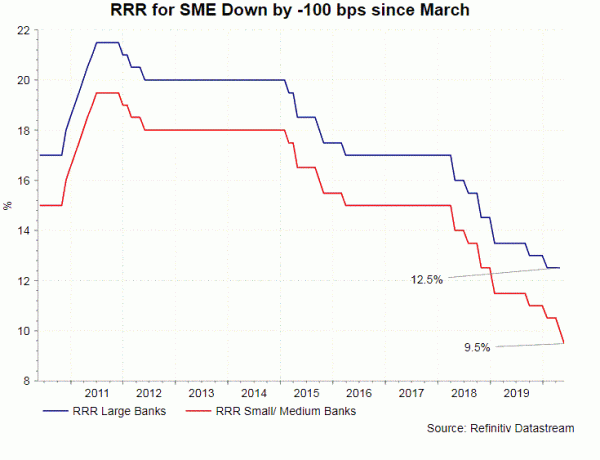PBOC this morning announced to leave the loan prime rate (LPR) unchanged at 3.85%. While this had been widely anticipated, it should not be interpreted as a signal of unwinding monetary stimulus. We believe the pause allows the central bank some time to assess the impact of previous easing measures on the economy. Despite upside surprise in April’s data, we expect the recovery to be gradual as it takes time for both domestic and external demand to pick up amidst pandemic uncertainty and resurgence of US-China trade conflict.
Loan prime rate (LPR), PBOC’s major policy rate, is the most preferential lending rate offered by a commercial bank to its prime clients. It is guided by the marginal lending facility (MLF) rate. With the MLF rate staying unchanged at 2.95% last Friday, the non-event on LRP today has been widely anticipated. Yet, it was indeed a surprise that the central bank left the rates unchanged despite signals of more easing at the quarterly monetary policy report released earlier in the month.
Recent data flows suggest that the worst of China’s economic contraction is behind us. As we mentioned in the previous China Watch report, the pace of recovery is very gradual and the process is thorny. While IP returned to growth, retail sales and FAI stayed in contraction. This suggests that recovery in the supply side is faster than the demand side. Despite signals of taming coronavirus pandemic, the reported cases in the US and European countries are still plenty. Removal of lockdown measures, while aiming at re-starting economic activities, could increase the risk of a second wave outbreak. Weakness in the job market in the US and a number of European countries should dampen global demand, leading to decline in China’s exports and harming the country’s recovery.
The pause in rate cut this month offers the authority more time to assess the impacts of previous easing measures on the economy. From PBOC’s perspective, monetary easing measures since the coronavirus outbreak early this year have been aggressive. The LRP, as well as the 7-day reverse repo rate, have been trimmed by -30 bps. Meanwhile, RRR for small and micro enterprises has been lowered by -100 bps. Together with fiscal stimulus implemented by the government, it is prudent for PBOC to assess the influence first before adding new ammunition. PBOC might also want to wait for explicit direction from the authority (a statement will likely be released after the “Two sessions” scheduled on May 21 & 22) on the monetary stance.
There are several reasons that we expect PBOC’s monetary stance will remain expansionary. At the quarterly monetary policy report released earlier this month, PBOC indicated that the prudent policy will be more “flexible” and “appropriate”, with the goal of maintaining “liquidity at a reasonably ample level”. Meanwhile, the reference that it will “avoid excess liquidity flooding the economy” is deleted. This might pave the way for more aggressive moves in coming months.
China’s economy has been slowing before the pandemic. Indeed, PBOC has lowered the RRR for both largest and small and medium banks by -250 bps and -150 bps in 2018 and 2019 respectively. Elevated inflation in 2H19 was prohibiting the central bank from more aggressive easing. Deceleration in inflation over the past few months should give PBOC more flexibility in adding more stimuli.
There are signs of resurgence of US-China trade tensions as US’ Donald Trump has threatened to raise tariff on Chinese exports and even cut the whole relationship with China. While we do not expect Trump to go that far in terminating trade with China, renewed uncertainty about trade conflicts and/or postponement of trade talks would be detrimental to China’s growth outlook. This suggesting that PBOC would have to maintain an accommodative policy stance.














